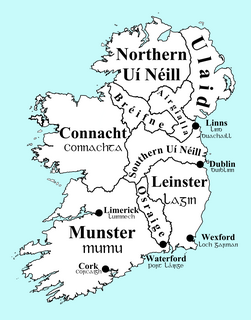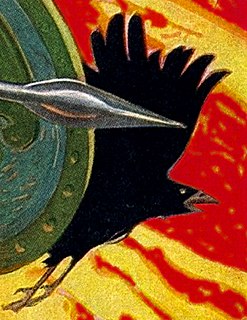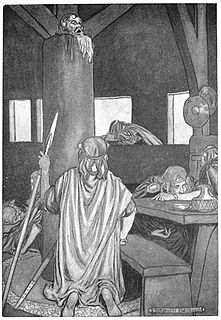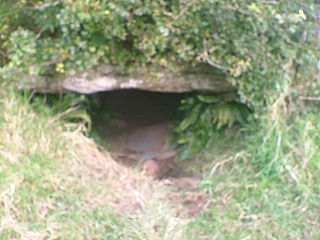This article needs additional citations for verification .(June 2018) (Learn how and when to remove this template message) |
Cethern mac Fintain is an Ulster warrior who aids Cúchulainn in the Táin Bó Cuailnge (Cattle Raid of Cooley), according to the Ulster Cycle of Irish mythology.

Ulaid or Ulaidh ) was a Gaelic over-kingdom in north-eastern Ireland during the Middle Ages, made up of a confederation of dynastic groups. Alternative names include Ulidia, which is the Latin form of Ulaid, as well as in Cóiced, which in Irish means "the Fifth". The king of Ulaid was called the rí Ulad or rí in Chóicid.
The Ulster Cycle, formerly known as the Red Branch Cycle, one of the four great cycles of Irish mythology, is a body of medieval Irish heroic legends and sagas of the traditional heroes of the Ulaid in what is now eastern Ulster and northern Leinster, particularly counties Armagh, Down and Louth, and taking place around or before the 1st century AD.

The mythology of pre-Christian Ireland did not entirely survive the conversion to Christianity. However, much of it was preserved in medieval Irish literature, though it was shorn of its religious meanings. This literature represents the most extensive and best preserved of all the branches of Celtic mythology. Although many of the manuscripts have not survived and much more material was probably never committed to writing, there is enough remaining to enable the identification of distinct, if overlapping, cycles: the Mythological Cycle, the Ulster Cycle, the Fenian Cycle and the Historical Cycle. There are also a number of extant mythological texts that do not fit into any of the cycles. Additionally, there are a large number of recorded folk tales that, while not strictly mythological, feature personages from one or more of these four cycles.
As Cúchulainn lay wounded after his combat with Ferdiad, Cethern entered the fray on his chariot, stark naked and armed only with a silver spike. He killed many men, but was severely wounded.

Ferdiad, son of Damán, son of Dáire, of the Fir Domnann, is a warrior of Connacht in the Ulster Cycle of Irish mythology. In the Táin Bó Cúailnge, Ferdiad finds himself on opposite sides to his best friend and foster-brother Cúchulainn who may also have been his lover, with whom he had trained in arms under the renowned warrior woman Scáthach. He and Cúchulainn are equal in all martial feats, with two exceptions: the Gáe Bulg, a barbed spear which Scáthach has taught only Cúchulainn to use; and Ferdiad's horny skin, which no weapon can pierce.

A chariot is a type of carriage driven by a charioteer, usually using horses to provide rapid motive power. Chariots were used by armies as transport or mobile archery platforms, for hunting or for racing, and as a conveniently fast way to travel for many ancient people.
Cúchulainn sent to the Connacht camp for doctors to tend to him. The first doctor told Cethern his wounds were fatal. Cethern punched his brains out the back of his head and asked for a second opinion. Forty-nine more doctors told him the same thing, and he killed all of them in turn, except one, who was only stunned. Finally Cúchulainn sent for Conchobar's doctor, Fingín.

Connacht, formerly spelled Connaught, is one of the provinces of Ireland, in the west of the country. Up to the 9th century it consisted of several independent major kingdoms.
Conchobarmac Nessa is the king of Ulster in the Ulster Cycle of Irish mythology. He rules from Emain Macha. He is usually said to be the son of the High King Fachtna Fáthach, although in some stories his father is the druid Cathbad, and he is usually known by his matronymic, mac Nessa: his mother is Ness, daughter of Eochaid Sálbuide, King of Ulster.
Fingín examined each of Cethern's wounds and was able to tell how he received them and from whom. He gave him two options. He could save his life, but the treatment would take a whole year; or he could make him fit to fight now, in which case he would survive only three more days. Cethern chose the latter. Fingín had Cúchulainn make a bath of bone marrow, and had Cethern sleep in it. He replaced some of his ribs with chariot parts, and tied the frame of the chariot to his belly to keep his insides in. Cethern's wife arrived with his weapons, and he went back into battle.
Bone marrow is a semi-solid tissue which may be found within the spongy or cancellous portions of bones. In birds and mammals, bone marrow is the primary site of new blood cell production or hematopoiesis. It is composed of hematopoietic cells, marrow adipose tissue, and supportive stromal cells. In adult humans, bone marrow is primarily located in the ribs, vertebrae, sternum, and bones of the pelvis. On average, bone marrow constitutes 4% of the total body mass of humans; in an adult having 65 kilograms of mass, bone marrow typically accounts for approximately 2.6 kilograms (5.7 lb).
The doctor who had only been stunned managed to reach the Connacht camp to warn them, and they put Ailill's crown on a standing stone as a decoy. Cethern put his sword and his fist through the stone. He killed men for a day and a night, until he was surrounded and died fighting.
Ailill mac Máta is the king of the Connachta and the husband of queen Medb in the Ulster Cycle of Irish mythology. He rules from Cruachan.





